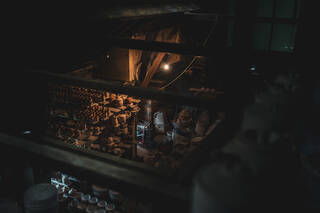Richard Batterham (1936 – 2021) was a renowned studio potter, who lived and worked in the village of Durweston, Dorset. He set up his pottery in 1959 and worked there independently for over 60 years, cultivating an instantly recognisable family of forms and a distinct making practice which set him apart from other potters of his time.

Richard Batterham was born in 1936 in Woking, Surrey. During the First World War Richard's family moved to Dorset, where he would later attend Bryanston School. It was here that he first started making pots, aged 13, taught by sculptor Donald Potter (1902 – 2004). As well as providing his introduction to pottery, Potter would remain a lifelong friend of Richard's. When he left school in 1954, Richard already knew that he wanted to be a potter. Between 1954 and 1956, he completed two years of National Service in Aldershot, Hampshire. During this time, he also spent a week at Wrecclesham Pottery in Surrey, one of the last surviving country potteries in Britain. Following this, he wrote to two established potteries asking for work: Ray Finch at the Winchcombe pottery in Gloucestershire and Bernard Leach at the Leach Pottery, St Ives, Cornwall. Leach offered him a week's trial at St Ives, so Richard moved there to begin working in September 1957.
The Leach Pottery was established by Bernard Leach (1887 – 1979) and Shoji Hamada (1894 – 1978) in 1920. The pottery remains one of the most influential in the world, and Leach and Hamada were foundational in the early 20th century Studio Pottery movement. At its core, the Studio Pottery movement emphasised the importance of the individual maker's role in pottery, and that a potter should be involved in all stages of making from conception to final product. When Richard arrived in St Ives in 1957, his trial went well, and he moved on to a two-year apprenticeship.

At the Leach Pottery, Richard met many makers, several of which had a great influence on his life and work. One of these was Atsuya Hamada (1931 – 1986), son of Shoji Hamada (1894 – 1978), one of the leading potters of the Japanese Mingei (Folk Craft) movement. Atsuya Hamada came to the Leach Pottery in 1956, just prior to Richard. Richard greatly admired Hamada's potting wheel. Hamada worked on a kick-wheel, which he brought with him from Japan. Powered by the potter's feet, it worked very differently to the more common mechanical wheels used at St Ives. When Richard established his own pottery, he had a kick-wheel made, modelled on Hamada's. Richard also met his wife Dinah Dunn (1930 – 2007) at the Leach Pottery. Dinah had been working there as a potter several years before Richard. After completing his apprenticeship in 1959, Richard and Dinah married and, a few months later, moved to Durweston in Dorset.
It was in this house in Durweston that Richard established himself as a potter. Initially, he set up a wheel in the main house, building a kiln at the end of the garden. His first firing was on New Year's Eve, 1959. Richard approached many local and small retailers and slowly built a loyal customer base selling directly from his home. He dealt with every step of the making of his pots, from mixing his own clay, to throwing and glazing, and firing in the kiln. Diligently pursuing his own interests, his forms and glazes evolved slowly over time, often inspired by use.
After his first exhibition in 1964 at the Hambledon Gallery – with his close friend Richard Bawden – he quickly had his first solo exhibition in 1965 at the Crafts Centre of Great Britain (now Contemporary Applied Arts) in Hay Hill, London. Even as he began making a name for himself in studio pottery circles, Richard remained uninfluenced by the work of those around him. Instead, he chose to develop his own focused style. Ensuring so much of himself went into his making, Richard didn't feel the need to mark his work. He preferred his pots to speak for themselves. In time, Richard's select range became so recognisably his, that there was no need for an identifying mark.

With his output increasing, Richard bought land across the road from his home and built a large pottery there in 1966. Inside, he designed a functional space, with the large four-chamber kiln in the centre. On the ground floor, he had rooms for throwing and glazing, a back room for mixing the clay, and beds for the clay in the pottery garden. Upstairs, as well as storage space, was a customer showroom.
Despite expanding, Richard continued working alone, allowing for the development of his pots over time, through repetition of forms, glazes and surface markings. Although he exhibited widely (both in the UK and internationally), was featured in publications and commercially successful, Richard's approach to making was always his first priority. His work and home life consistently influenced each other, many of his pots inspired by needs from the day-to-day of his family life. Some of his most commercially successful pieces came from those he used in his own home. There was never a hierarchy for him between form and function: a used pot was equally as important as an unused pot. Also, crucial to influencing what he made was the practicalities of the kiln. Certain shapes and glazes would need to be fired in particular areas of the kiln, to achieve the right firing temperatures. So, to make a firing as efficient and cost-effective as possible, Richard would make forms that fitted together, depending on his packing.

To commit to a making practice of such self-sufficiency was no mean feat. Combining a huge output with his fineness of execution, Richard Batterham inspired many visitors to Durweston all the way up to his final firings in 2019.
Find out more about Richard Batterham's working methods.


